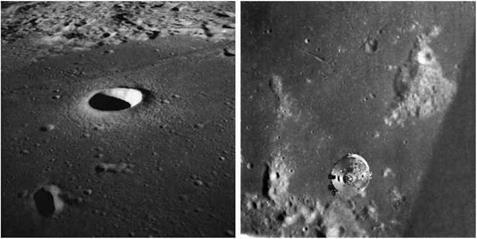A DRESS REHEARSAL: APOLLO 10
Most of the major components and procedures required for a Moon landing had been tested, though not always in the context in which they would be needed during a lunar flight. In order to minimise the surprises that might face the landing mission, NASA wanted to practise a complete lunar mission as far as they dare, short of beginning the final descent to the Moon. This dress rehearsal flight, the F-mission, was accomplished by Apollo 10, flown by Tom Stafford, Eugene Cernan and John Young. Their spacecraft were named after characters in Charles Schulz’s popular cartoon strip Peanuts, who had also featured in NASA campaigns to promote quality control in the programme. The CSM was therefore named Charlie Brown while the LM took the name Snoopy.
Launch took place on 18 May 1969 and. for the first time, all the functions of the CSM to take a lunar module to an orbit 110 kilometres above the Moon had to work. Once the two docked spacecraft had successfully entered a lunar parking orbit, the crew settled down for their first night in the Moon’s vicinity as their ship hurtled above its surface at 5.800 kilometres per hour. Next day. Stafford and Cernan entered Snoopy’і cabin, separated from Young in Charlie Brown, and took the LM into the same low orbit from which a landing mission would make its final descent. This orbit brought Snoopy down to an altitude of less than 14,500 metres above the lunar terrain from where Stafford photographed and described the approach to the landing site that had been selected. The most important task was to prove that lunar
|
Waypoints to a landing. Left, crater Moltke at 6-km diameter. Right, the Apollo 10 CSM Charlie Brown flies above a triangular feature named ‘Mount Marilyn’ by Jim Lovell. Both features led to way to the Apollo 11 landing site. (NASA) |
orbit rendezvous would work as planned. After they jettisoned the descent stage, the ascent engine was used to set up an orbital situation similar to that which would be presented after lift-off from the Moon. NASA’s management had once been wary of the idea of two speeding craft being brought into close proximity while in orbit around another world, and they wished to prove that their techniques worked prior to committing a lander to the surface. This successful rendezvous and docking finally cleared the way to a landing attempt.
Thanks to the usual predictability of the gathered media, Apollo 10 is more often remembered for the ‘son-of-a-bitch’ language Cernan used when a pilot error caused the LM to gyrate unexpectedly as the descent stage was being jettisoned. The journey home was uneventful except for the unprecedented colour television coverage of a receding Moon that was beamed to Earth soon after Charlie Brown’s SPS engine was fired. Stafford had promoted the importance of TV on Apollo, not only to the public, but also to engineers and lunar scientists. The 8-day flight of Apollo 10 put NASA on the home straight, leaving the G-mission with no unknowns except the landing itself.











